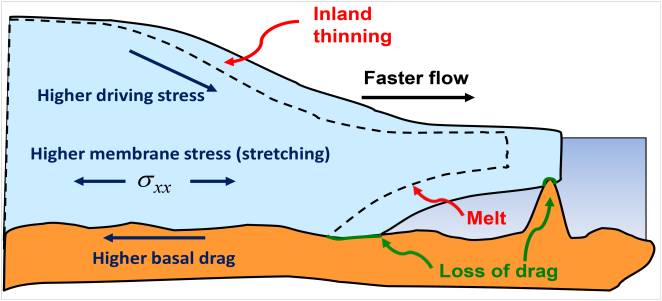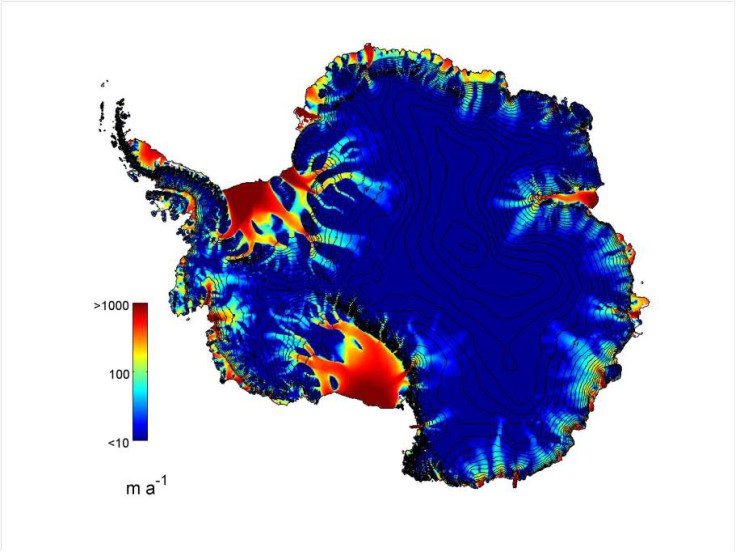Propagation of ocean-driven ice-shelf thinning and consequences for the interior of Antarctica and global sea level
- Start date
- 1 April, 2014
- End date
- 31 March, 2019
By exploiting advances in ice sheet modelling, and new Antarctic-wide datasets, this project aims to predict how far and how fast the observed ocean-driven thinning of floating ice shelves will propagate into the interior of the Antarctic ice sheet, and assess the consequences for global sea level over decadal-to-centennial timescales.
As it is buried by fresh snowfall, the snow that falls in Antarctica compacts into ice and then flows like a viscous fluid towards the coast. There it breaks off as icebergs, or melts into the ocean.
Ocean-driven melting of floating ice shelves can lead to thinner ice in the interior of Antarctica, not simply because the ice melts, but because it flows faster, stretches and thins (Figure 1). Glaciologists think melting by the ocean can start a chain of consequences: (i) melting causes loss of contact with pinning points or retreat of the grounding line (i.e. the line where the ice first goes afloat). This lowers drag from the friction of ice sliding over rock or sediment and reduces the resistance to ice flowing across the grounding line; (ii) faster flow near the grounding line causes more horizontal stretching leading to thinning just upstream; (iii) if this thinning continues it creates steeper surface slopes which increases the stress that drives the ice forwards; (iv) the faster flow inland causes thinning to propagate even further into the interior of the ice sheet, increasing the contribution to sea level rise.

In this project we used a new approach to find out how fast the ice beneath the surface of the ice sheet is moving. Knowing what is happening at the base of the ice is crucial to understanding how ice flows as a whole but it is extremely difficult to make any direct measurements so far beneath the surface. The mathematical techniques are borrowed from electrical impedance tomography which can provide image of the inside of the human body using electrical measurements from outside. Instead of electrical measurements, we use forces and flow speed at the upper surface of the ice. These are combined with a computer model of ice flow, to reveal for instance how fast the ice is flowing beneath the surfacehow slippery the underside of the ice sheet is.
We have already built up an accurate picture of how the ice is moving today and the next step will be to run the computer model forward in time to make a forecast of how Antarctica will change in future. This will help us to assess what consequences any future changes in Antarctica might have on global sea level.

- To decipher whether the observed thinning of Antarctic ice shelves will cause large amounts of ice to be delivered from the interior of the Antarctic ice sheet into the ocean, and if so, how much, and how quickly
- To understand the relative importance of mechanisms responsible for the propagation of ocean-driven thinning of ice shelves into the interior of Antarctica, and develop a capacity to include these mechanisms in predictive models of ice sheet interaction with the ocean.To find out what is causing the observed changes to propagate hundreds of kilometres inland in some sectors of Antarctica, but only a few tens of kilometres in others
- To test model developments against satellite observations
- To determine how accurately Earth System Models must calculate basal melt of ice shelves if they are to give useful predictions of the consequences for sea level rise
